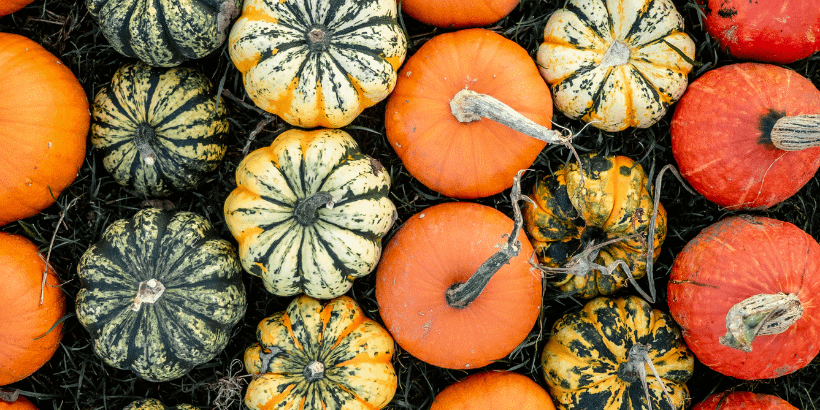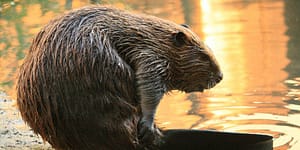Gourdness Gracious! The History of Pumpkins and Gourds

When you think of pumpkins, do you think of Halloween or a sweet dessert? But how did pumpkins become the holiday staple they are today?
Keep reading to learn more about the rich history of this sweet fall edible icon!
The following is an excerpt from The Seed Detective by Adam Alexander. It has been adapted for the web.
Pumpkins & Gourds: A Rich History
The story of the domestication of squash begins with C. pepo. It is native to North America and has been cultivated by indigenous peoples for thousands of years. The wild parents of C. pepo were similar in many ways to the native African gourds. Small, with very hard skins, a bitter and fibrous flesh, and few seeds.
In fact, many so-called ‘ornamental gourds’ which continue to be popular among some growers today are little different genetically to wild C. pepo. The bitterness is due to the presence of the chemical cucurbitacin, which the plant employs as a defence against herbivores. Even small amounts can cause stomach ulcers and has been known to kill unsuspecting eaters.
The Domestication of Squash
The lengthy domestication of C. pepo resulted in two sub-species. The first, C. pepo subsp. pepo, was brought back by Columbus on his return from Hispaniola in 1493 and begat the eight different types of summer squash described earlier.
The second, C. pepo subsp. ovifera, includes the storing type of acorn squash, which is a regular in my garden. Dark green, almost black, with deeply ribbed fruits, Table Queen is a favourite.

Introducing….Pumpkins!
Another member of this sub-species is the bright orange specimens generally called a pumpkin that are the decorative centerpiece of Halloween celebrations and the key ingredient of ‘pumpkin pie’. In the sixteenth century there was no systematic means of classification, so all cylindrical varieties were known as marrows and crooknecks, and round types were called pumpkins, scallops, melons or acorns.
Pompeons, Melons, and Gourds — Oh My!
Fifty years after the first New World squash arrived in Italy, many botanists used both pepo and pepon to describe types of melon – which are native to the Old World – too. By the second half of the sixteenth century, however, melon was also used in English to describe pumpkins!
Courge – which was subsequently anglicised to ‘courgette’ – was also used by explorers and botanists alike over the following 200 years to describe pumpkins, squash and bottle gourds. Although botanists were already recognising distinct differences and traits in the various groups and types of cucurbits, they persisted in calling all forms of squash pompeons, melons and gourds.
 Gourds or Pompeons? Deciding On A Name
Gourds or Pompeons? Deciding On A Name
Even Carl Linnaeus (1707–1778) considered all gourds and squash to be of the genus Cucurbita. Gourds were only assigned their own genus Lagenaria by the botanist Juan Ignacio Molina (1740–1829), after Linnaeus died. The American botanist Edward Lewis Sturtevant (1842–1898)4 suggests that the different shapes of both summer and winter squash led to the confusion in their naming.
Large, round ones were called pompeons; those with hard rinds kept for winter use were known as gourds and small round ones as melons. One of the easiest ways to distinguish gourds from squash is that the former have white flowers and the latter, yellow, but it took over 200 years for the penny to drop. All four New World squash also have easily identifiable and distinct appearances.*
The Rise of Pumpkins
After a slow start – like so many vegetables at the time, considered only fit for the poor – squash became a popular food in European diets. By the end of the sixteenth century the British had lumped together all the different species of large, hard-skinned squash that had been brought back from their American colonies and called them ‘pumpeons’.
They grew well in an English climate and soon the name morphed into pumpkin. Combining the sweet flesh with dried fruits, apples and spices, and then baking this in a pastry base was a popular dish. Thus was born what was to become an icon of colonial American cuisine: pumpkin pie.
 Early Uses of Pumpkins
Early Uses of Pumpkins
This love affair with hard-skinned types of C. pepo and other hard-skinned species, mostly C. maxima (which is what the Algonquin cultivated), coincided with the colonisation of North America. Their great value in the USA in the seventeenth century was as animal fodder and, in extremis, for human consumption.
The early colonisers did not have ovens, so would cut the top off their pumpkins, remove the seeds and fill the cavity with a mixture of milk, spices and something sweet like honey. After replacing the top, the stuffed vegetable was pushed into the ashes of a fire to bake slowly.
What resulted was a thick creamy custard, not dissimilar to the filling of today’s pumpkin pie. The flesh was also used to make a type of bread or cake and fermented to make beer. As Europeans moved west, they were able to trade and cultivate squash, which formed the staple of much Native American food culture.
Recommended Reads
Seasonal Desserts: Apple Spice Bundt Cake & Pumpkin Pie with Hazelnut Crust
Recent Articles
The Garlic Clove! This small crop adds a big punch of flavor that complements almost every delicious dish you could think of. And the best part? These two recipes are a breeze to make together!
Read MoreBeavers are ecological and hydrological Swiss Army knives. Capable of tackling just about any landscape-scale problem you might confront.
Read MoreOur love affair with amaranth began long before the pseudo-grain became a trendy staple for gluten-free folk. The luscious leaves of this annual plant are not only packed with a plethora of health benefits.
Read MoreDon’t know where to start for foraging wild plants? Read on for the information you need to begin foraging on your own: where to do it and how to be safe.
Read MoreWhen you’re walking around the grocery store looking at the vegetables, it’s probably hard to imagine that a century ago there was twice the amount of options.
Read More










